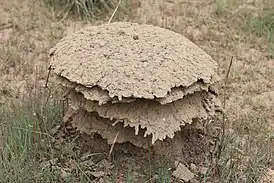Cubitermitinae
Cubitermitinae (лат.) — подсемейство термитов из семейства Termitidae. Около 150 видов[2].
Cubitermitinae | ||||||||||||
|---|---|---|---|---|---|---|---|---|---|---|---|---|
 | ||||||||||||
| Научная классификация | ||||||||||||
|
||||||||||||
| Латинское название | ||||||||||||
| Cubitermitinae Weidner, 1956[1] | ||||||||||||
|

Распространение
Встречаются в Афротропика[2].
Описание
Усики имаго самок и самцов 15—17-члениковые, лабрум равной ширины и длины. Жвалы имаго сходны с мандибулами рабочих: апикальный зубец левой челюсти длиннее чем слитые 1—2-й маргинальные зубцы. Формула шпор голеней: 3-2-2. Усики солдат 14—15-члениковые[2].
Систематика
26 родов, около 150 видов. Ранее рассматривалось в качестве трибы Cubitermitini в составе подсемейства Termitinae. Однако недавние исследования показали (Noirot, 2001; Inward et al., 2007)[3], что африканские роды этой подгруппы составляют монофилетическую кладу в составе Termitidae, и статус трибы был повышен до отдельного подсемейства (Engel et al. 2009; Krishna et al., 2013)[2][4][5].
- Apilitermes Holmgren, 1912
- Basidentitermes Holmgren, 1912
- Batillitermes Uys, 1994
- Crenetermes Silvestri, 1912
- Cubitermes Wasmann, 1906[6][7]
- Euchilotermes Silvestri, 1914
- Fastigitermes Sjöstedt, 1924
- Forfculitermes Emerson, 1960
- Furculitermes Emerson, 1960
- Lepidotermes Sjöstedt, 1924
- Megagnathotermes Silvestri, 1914
- Mucrotermes Emerson, 1960
- Nitiditermes Emerson, 1960
- Noditermes Sjöstedt, 1924
- Okavangotermes Coaton, 1971
- Ophiotermes Sjöstedt, 1924
- Orthotermes Silvestri, 1914
- Ovambotermes Coaton, 1971
- Pilotermes Emerson, 1960
- Proboscitermes Sjöstedt, 1924
- Procubitermes Silvestri, 1914
- Profastigitermes Emerson, 1960
- Toracotermes Wasmann, 1911
- Trapellitermes
- Unguitermes Sjöstedt, 1924
- Unicornitermes Coaton, 1971
Примечания
- Weidner, H. 1956. "Beiträge zur Kenntnis der Termiten Angolas, hauptsächlich auf Grund der Sammlungen und Beobachtungen von A. de Barros Machado (I. Beitrag)." Publicações Culturais da Companhia de Diamantes de Angola 29: 55—106.
- Krishna, Kumar.; Grimaldi, David A.; Krishna, Valerie.; Engel, Michael S. 2013. Treatise on the Isoptera of the world. — Bulletin of the American Museum of Natural History, no. 377: pp.1—2704 (vol. 1-7). ISSN 0003-0090
- Noirot, C. 2001. Te gut of termites (Isoptera). Comparative anatomy, systematics, phylogeny. II. Higher termites (Termitidae). Annales de la Société Entomologique de France (n.s.) 37 (4): 431—471.
- Engel Michael S. Family-group names for termites (Isoptera), redux (англ.) // ZooKeys. — 2011. — Vol. 148. — P. 171–184.
- Engel M. S., Grimaldi D. A., Krishna K. (2009). Termites (Isoptera): Teir phylogeny, classifcation, and rise to ecological dominance. — American Museum Novitates 3650: 1—27. doi:10.1206/651.1
- Ruelle, J. E. 1992. The genus Cubitermes Wasmann (Isoptera: Termitidae: Termitinae): a review of its taxonomy, nomenclature and distribution in Africa. Journal of African Zoology 106: 499—502.
- Williams, R. M. C. 1966. The East African termites of the genus Cubitermes (Isoptera: Termitidae). Transactions of the Royal Entomological Society of London 118 (4): 73—118.
Литература
- Bourguignon, T. et al. Towards a revision of the Neotropical soldierless termites (Isoptera: Termitidae): redescription of the genus Anoplotermes and description of Longustitermes, gen. nov. (англ.) // Invertebrate systematics. — 2010. — Vol. 24, no. 4. — P. 357—370. doi: 10.1071/IS10012
Ссылки
- Termitidae (англ.) (недоступная ссылка). bugguide.net. Дата обращения: 18 марта 2011. Архивировано 19 апреля 2012 года.
- Termitidae (англ.) (недоступная ссылка). Tree of Life. Дата обращения: 18 марта 2011. Архивировано 19 апреля 2012 года.
- Cubitermitinae на сайте eol.org
